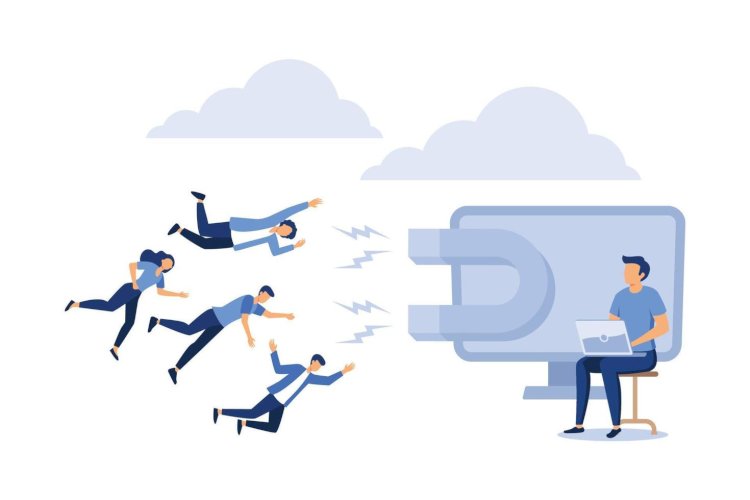How early-stage startups can attract and retain customers

Attracting customers to your new start-up business can be difficult because you are new to the market and there are already many sites like yours. Furthermore, customer retention is critical to your company's growth and survival. Customer retention and brand loyalty efforts help enterprises and start-ups in retaining customers from the first point of contact with your company to a lifelong relationship. Several factors influence customer engagement and retention, including customer service, responding to feedback, delivering targeted offers, and others.
It could also be referred to as creative ways to attract customers for your startup. Customers are essential to any business, including start-ups. As a result, most businesses focus their efforts on acquiring new customers and converting leads via various marketing methods.
These methods taught users how to find new customers and increase sales. Or how do you attract customers away from competitors? Customer retention has numerous advantages for businesses, particularly start-ups. As a result, as a business, you must make efforts and implement strategies to improve customer retention and engagement.
The Importance of Customer Retention and Engagement
- Customer retention refers to a company's ability to keep its existing customers by developing positive relationships with them. By cultivating good relationships with its current customers and providing good services, the company can retain them. Marketing to an existing customer outperforms selling to someone who has never purchased from you before by 40%. Customer retention is a difficult process because retaining an existing client base requires more active participation and consumer engagement than acquiring new ones.
- With the rise of e-commerce and social media marketing, businesses have realized that building customer loyalty is absolutely essential in this highly competitive market. The COVID-19 lockdown, in particular, has shed light on changing consumer behaviour and revolutionized customer purchasing behaviour. The most visible manifestation of such revolutionary shifts is the increased use of social media and internet websites to purchase goods and services rather than visiting physical stores. Consumers no longer buy things just to buy them or choose them at random. This is due to the fact that consumers do more than just buy a product; they also add value to their lives. They are only a few keystrokes away from switching to another company that meets their needs.
- A customer-oriented business strategy can make a company more responsive and receptive to the needs of its customers, making it more resistant to market competition. Major customer retention benefits can thus help you identify the industry's pattern of product and service development and enhancement in order to increase your company's retention rate. Because more people are investing in startups these days, entrepreneurs must place a premium on customer retention. It also increases the Return on Investment (ROI) without causing a loss to the organization. Increased revenue generation, higher levels of customer satisfaction, and client loyalty are all indicators of a higher retention rate.
- According to a survey, engaged customers are likely to earn 1.7 times more than disengaged customers. Employees and engaged customers have the potential to generate up to 3.4 times the average revenue. When compared to one-time customers, loyal customers can increase a company's total revenue. They also serve as a barrier against inclement weather and rising competitive pressures.
The Advantages of Customer Retention and Engagement
Some of the advantages of customer retention and engagement for new businesses and startups include:
Low Marketing Costs: Obtaining new customers take a significant amount of time, effort, and money. Consumers who show genuine interest in the product or service you provide and a willingness to buy increase the likelihood of converting such customers and generating a transaction by focusing marketing techniques on current customers. This not only saves money on advertising but also shows the brand's commitment to rewarding customer loyalty.
Loyal Customers Increase Sales: because they have a connection with the company and are more likely than new customers to believe the company and specifically the brand. Because they've been with the company for a while and are familiar with the service or product you offer, an existing client is more likely to convert or make repeat purchases through your site. Additionally, loyal customers spread the word more effectively, lowering your customer acquisition costs.
Improves Communication Effectiveness: Customers who are engaged and loyal to you are typically easy to approach and are already acquainted with your communication methods. This means they'll be more forgiving if the service isn't up to par or if a problem arises. It also implies that your messages were more likely to be interacted with by consumers, such as reading emails or providing positive product feedback.
Enhance Brand Image: A customer's perception of a company's products and services is referred to as brand image. A positive brand image helps with customer acquisition, cross-selling and upselling, and marketing cost reduction. One of the most advantageous aspects of customer loyalty is that the company gains a better understanding of its customers and their needs. The information gathered aids in the development of personalised and targeted campaigns, increasing the likelihood of success.
Create a Strong Customer Relationship: Developing strong and dependable customer relationships is often part of focusing on client retention, such as demonstrating gratitude through loyalty programmes or providing excellent customer service in the event of a problem. Customers will appreciate your attentiveness and responsiveness and become more loyal to your brand as a result.
Verbal Advertising: Customers who are loyal to your brand are more likely to recommend it to others and positively advertise it. This is essentially free advertising, and because it is genuine and has no hidden or insignificant goals, it may have a much greater effect on potential customers. In addition to being free, this kind of promotion can increase customer loyalty because customers start out with a positive perception of your brand.

Tips for Start-Ups for Retaining and Attracting Customers
- Establishment of a Specific Goal: Customers frequently have market-specific demands. Businesses, on the other hand, struggle to meet these expectations; thus, outlining your objectives ahead of time can help your clients better understand your offerings. Furthermore, this will boost your customers' trust in your brand and their belief in your products and services, encouraging them to stay loyal to your company in the long run. Customers may be persuaded to buy from you if an organization's goals for quantity and quality of service are met.
- Direct Response Marketing: Through direct response marketing, prospective customers are enticed to take specific, urgent actions. You can use direct response marketing to entice customers to join your mailing list or any other contact method, which will allow you to contact them in a variety of ways and encourage them to make a purchase. In exchange for contact information, you can also send ebooks or templates. Furthermore, make certain that your messaging addresses the primary concerns of your potential customers. Direct response marketing aims to respond quickly to the needs of your potential customers and demonstrate the value your company provides.
- Requesting Referrals: Referral programmes can help you retain and attract more potential customers. This is where you can put your customers and users to good use. They can serve as a conduit for you to share your company's news with your friends, colleagues, and others. People will believe these referrals because their friends have already used your services, ensuring greater authenticity. You must capitalise on your customers' trust. Create a strategy for actively seeking recommendations from your satisfied customers.
- Email Marketing: With email automation, you can reach out to customers right away with personalised communications and offer them something in exchange for their time. Customers are notified of special offers or promotions, and product instructions and industry training are provided. It is critical to understand your customers' feedback by sending follow-up emails to ensure that they are satisfied with the service and purchase.
- Collaboration with Influencers: Influencers are people who have built a reputation or an audience through social networking sites or through their extraordinary talents or work. Influencers who support a company's goals or strategy may form alliances with it. Influencers can sell and promote your product by recommending it to their followers, using it, wearing it, or discussing it with their audience. If the business products and sales infrastructure are in place, influencers can help build worth through direct personal experience to influence purchasing. Influencers in the firm's niche may be able to help the brand reach out to more customers.
- Customer Admiration: Giving away free items may not seem like the most logical small business strategy, especially if you're starting out on a shoestring budget. Customers will almost certainly associate some value with the awards provided by your company; as a result, the incentives or rewards that you provide will be more valuable to them. This link between awards and your company would improve the company's reputation and serve as an appealing and engaging force for these customers. This may increase their desire to buy from your brand in the future and recommend it to their friends.
- Customer feedback is an important customer retention strategy that can help a company determine whether its services are satisfactory or not. Any disparity between these can be easily identified by actively seeking and reviewing consumer feedback in order to improve your services and products. Furthermore, customer feedback can provide insight into what they think about your brand and help you better understand their emotions toward it. As a result, you will have a better understanding of their expectations and will be able to incorporate them into your products and services, thus improving Customer Service Management.
- Use Online Reviews and Ratings: In both the B2B and B2C industries, customers generally rely on online ratings and reviews when making purchases. As a result, you must keep track of the services and respond to any complaints in order to maintain excellent reviews and ratings. You can also encourage your customers to share their experiences and reviews so that your website has a better first impression.
- Make quarterly plans: When you have all relevant information and resources organised, you can begin developing well-researched quarterly strategies to attract potential customers. It is critical to understand that three months will provide enough time to make progress and track outcomes without overwhelming you with the pressure of meeting those goals in a short period of time. Every stage of your strategy should be structured to complement the goals you established in step one.
- Create an Affiliate Program: Affiliate programmes, like working with influencers, enable your customers to sell on your behalf. An affiliate is someone who is compensated for each sale or referral made to a company through their website, social media platform, or other related channels. Furthermore, affiliates increase the number of customers who understand the company and its products by encouraging them to discuss it.
Conclusion
Customer acquisition and retention should not be regarded as mutually exclusive aspects of the business development process. While the former can assist the company in expanding, the latter is required. It is difficult to distinguish your brand from your competitors in today's extremely competitive environment. Customer retention and customer loyalty are critical business drivers. A satisfied customer is more likely to recommend your company to others and to recommend you to them. Customer retention takes time to implement. However, prioritising it for implementation is one of the most important factors.

 Lalita Singh
Lalita Singh 






















